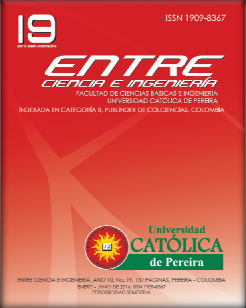Control óptimo conmutado de un convertidor CC-CC
DOI:
https://doi.org/10.31908/19098367.440Palabras clave:
control bang-bang, , control óptimo conmutado, convertidor de potencia Buck, principio del máximo de PontryaginResumen
El presente artículo aborda el control de circuitos convertidores de potencia empleando control óptimo conmutado. Se realiza el diseño y la simulación para un convertidor CC-CC tipo reductor (Buck) y posteriormente se ajusta para el mismo un lazo realimentado en el cual se verifica el efecto de una acción de tipo proporcional de alta ganancia (encendido-apagado) a manera de punto de referencia convencional, para atenuar la incidencia de perturbaciones aplicadas en el sistema. Posteriormente y empleando un enfoque basado en el principio del máximo de Pontryagin, se diseña e implementa, a través de simulación, una técnica de control óptimo conmutado (bang-bang) que permite obtener un desempeño comparable con la acción encendidoapagado en términos de características dinámicas. Pruebas adicionales permiten cuantificar la optimalidad de la técnica propuesta y verificar el desempeño del sistema controlado en términos energéticos, mostrando que un control óptimo conmutado presenta además de la minimización del funcional de costo (mínima energía del error), una menor incidencia en la generación de ruidos por conmutación de alta frecuencia, en comparación con la técnica convencional. Trabajo adicional incluye la verificación experimental en laboratorio para los resultados de simulación presentados
Descargas
Referencias
I. E. Agency, “Key world energy statistics 2014,” 2014.
D. W. Hart, Electrónica de Potencia. Pearson Educación, SA, 2001.
J. G. Kassakian, M. F. Schlecht, and G. C. Verghese, Principles of power electronics. Addison-Wesley Reading, USA, 1991.
R. W. Erickson and D. Maksimovic, Fundamentals of power electronics. Springer, 2001.
V. Utkin, J. Guldner, and M. Shijun, Sliding mode control in electromechanical systems. CRC press, 1999, vol. 34.
H. Sira-Ramírez and R. Silva-Ortigoza, Control design techniques in power electronics devices. Springer, 2006.
C. Elmas, O. Deperlioglu, and H. H. Sayan, “Adaptive fuzzy logic controller for dc–dc converters,” Expert Systems with Applications, vol. 36, no. 2, pp. 1540–1548, 2009.
R. Sepulchre, M. Jankovic, and P. V. Kokotovic, Constructive nonlinear control. Springer-Verlag, Berlin., 1997.
M. Pahlevaninezhad, P. Das, J. Drobnik, G. Moschopoulos, P. K. Jain, and A. Bakhshai, “A nonlinear optimal control approach based on the control-lyapunov function for an ac/dc converter used in electric vehicles,” Industrial Informatics, IEEE Transactions on, vol. 8, no. 3, pp. 596–614, 2012.
X. Liu, G. Zhang, D. Yang, T. Shi, and X. He, “Discrete-time optimal control of photovoltaic grid-connected inverter based on particle swarm optimization,” Mathematical Problems in Engineering, 2014.
di Bernardo, M., Budd, C., Champneys, A.R., and Kowalczyk, P. Piecewise-smooth dynamical systems: theory and applications. London: Springer-Verlag, 2008.
Goebel, R., Sanfelice, R. G. and Teel, A. R. Hybrid dynamical systems. IEEE Control Systems Magazine, vol.29 (2), pp. 28-93, 2009.
Rubaai, A. and Jerry, J. Hybrid fuzzy bang-bang mode controller with switching function for electric motor drives applications. Industry Applications IEEE Transactions on, vol. 50 (3), pp. 2269-2276, 2014.
N. Aghasadeghi, A. Long, and T. Bretl, “Inverse optimal control for a hybrid dynamical system with impacts,” in Robotics and Automation (ICRA), 2012 IEEE International Conference on. IEEE, 2012, pp. 4962–4967.
R.W.H. Sargent, Optimal control, Journal of Computational and Applied Mathematics, Volume 124, Issues 1–2, pp. 361-371. 2000.
Xuping Xu; Antsaklis, P.J., “Optimal control of switched systems based on parameterization of the switching instants,” in Automatic Control, IEEE Transactions on , vol.49, no.1, pp.2-16, Jan. 2004.
Shahid Shaikh, M.; Caines, P.E., “On the Hybrid Optimal Control Problem: Theory and Algorithms,” in Automatic Control, IEEE Transactions on , vol.52, no.9, pp.1587-1603, Sept. 2007.
Jian Xu; Qijun Chen, “Optimal control of switched hybrid systems,” in Control Conference (ASCC), 2011 8th Asian , vol., no., pp.1216- 1220, 15-18 May 2011.
Sorin C. Bengea, Raymond A. DeCarlo, Optimal control of switching systems, Automatica, Volume 41, Issue 1, January 2005, Pages 11-27.
Ghomanjani, F.; Farahi, M. H., “Optimal Control of Switched Systems based on Bezier Control Points,” in I. J. Intelligent Systems and Applications , vol.4, no.7, pp.16-22, Jun. 2012.
Lucas, S.K.; Kaya, C.Y., “Switching-time computation for bang-bang control laws,” American Control Conference, 2001. Proceedings of the 2001 , vol.1, no., pp.176,181 vol.1, 2001.
X. Wang. Solving optimal control problems with MATLAB: Indirect methods. Technical report, ISE Dept., NCSU, 2009.
Optimization Toolbox™ User’s Guide, The MathWorks, Inc., 2015




 <
<
 Revista Entre Ciencia e Ingeniería
Revista Entre Ciencia e Ingeniería .png) entrecei@ucp.edu.co
entrecei@ucp.edu.co.png) ISSN (Impreso) 1909-8367 - ISSN (En Línea) 2539-4169
ISSN (Impreso) 1909-8367 - ISSN (En Línea) 2539-4169 Attribution-NonCommercial 4.0 International (CC By-NC 4.0)
Attribution-NonCommercial 4.0 International (CC By-NC 4.0)
.png) Carrera 21 No. 49-95 Av. de las Américas, Pereira, Risaralda, Colombia
Carrera 21 No. 49-95 Av. de las Américas, Pereira, Risaralda, Colombia